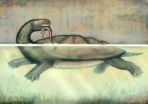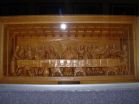(Press-News.org) Picture a turtle the size of a Smart car, with a shell large enough to double as a kiddie pool. Paleontologists from North Carolina State University have found just such a specimen – the fossilized remains of a 60-million-year-old South American giant that lived in what is now Colombia.
The turtle in question is Carbonemys cofrinii, which means "coal turtle," and is part of a group of side-necked turtles known as pelomedusoides. The fossil was named Carbonemys because it was discovered in 2005 in a coal mine that was part of northern Colombia's Cerrejon formation. The specimen's skull measures 24 centimeters, roughly the size of a regulation NFL football. The shell which was recovered nearby - and is believed to belong to the same species - measures 172 centimeters, or about 5 feet 7 inches, long. That's the same height as Edwin Cadena, the NC State doctoral student who discovered the fossil.
"We had recovered smaller turtle specimens from the site. But after spending about four days working on uncovering the shell, I realized that this particular turtle was the biggest anyone had found in this area for this time period – and it gave us the first evidence of giantism in freshwater turtles," Cadena says.
Smaller relatives of Carbonemys existed alongside dinosaurs. But the giant version appeared five million years after the dinosaurs vanished, during a period when giant varieties of many different reptiles – including Titanoboa cerrejonensis, the largest snake ever discovered – lived in this part of South America. Researchers believe that a combination of changes in the ecosystem, including fewer predators, a larger habitat area, plentiful food supply and climate changes, worked together to allow these giant species to survive. Carbonemys' habitat would have resembled a much warmer modern-day Orinoco or Amazon River delta.
In addition to the turtle's huge size, the fossil also shows that this particular turtle had massive, powerful jaws that would have enabled the omnivore to eat anything nearby – from mollusks to smaller turtles or even crocodiles.
Thus far, only one specimen of this size has been recovered. Dr. Dan Ksepka, NC State paleontologist and research associate at the North Carolina Museum of Natural Sciences, believes that this is because a turtle of this size would need a large territory in order to obtain enough food to survive. "It's like having one big snapping turtle living in the middle of a lake," says Ksepka, co-author of the paper describing the find. "That turtle survives because it has eaten all of the major competitors for resources. We found many bite-marked shells at this site that show crocodilians preyed on side-necked turtles. None would have bothered an adult Carbonemys, though – in fact smaller crocs would have been easy prey for this behemoth."
The paleontologists' findings appear in the Journal of Systematic Palaeontology. Dr. Carlos Jaramillo from the Smithsonian Tropical Research Institute in Panama and Dr. Jonathan Bloch from the Florida Museum of Natural History contributed to the work. The research was funded by grants from the Smithsonian Institute and the National Science Foundation.
INFORMATION:
Note to editors: An abstract of the paper follows.
"New pelomedusoid turtles from the late Palaeocene Cerrejon Formation of Colombia and their implications for phylogeny and body size evolution"
Authors: Edwin Cadena, Dan Ksepka, North Carolina State University; Carlos Jaramillo, Smithsonian Tropical Research Institute, Panama; Jonathan Bloch, Florida Museum of Natural History
Published: In the Journal of Systematic Palaeontology
Abstract:
Pelomedusoides comprises five moderate-sized extant genera with an entirely southern hemisphere distribution, but the fossil record of these turtles reveals a great diversity of extinct taxa, documents several instances of gigantism, and indicates a complex palaeobiogeographical history for the clade. Here, we report new pelomedusoid turtle fossils from the late Palaeocene Cerrejon Formation of Colombia. The most complete of these is represented by a large skull (condylobasal length ´ = 16 cm) and is described as Carbonemys cofrinii gen. et sp. nov. (Podocnemididae). Carbonemys is incorporated into a parsimony analysis utilizing a modified morphological character matrix designed to test relationships within Panpelomedusoides, with the addition of molecular data from seven genes (12S RNA, cytochrome b, ND4, NT3, R35, RAG-1 and RAG-2) drawn from previous studies of extant Podocnemididae. C. cofrinii is recovered within Podocnemididae in the results of both morphology-only and combined morphological and molecular (total evidence) analyses. However, molecular data strongly impact the inferred relationships of C. cofrinii and several other fossil taxa by altering the relative positions of the extant taxa Peltocephalus and Erymnochelys. This resulted in C. cofrinii being recovered within the crown clade Podocnemididae in the morphology-only analysis, but outside of Podocnemididae in the combined analysis. Two panpodocnemidid turtle taxa of uncertain affinities are represented by new diagnostic shell material from the Cerrejon Formation, though we refrain from naming them pending discovery of associated cranial material. One of these shells potentially belongs to C. cofrinii and represents the second largest pleurodiran turtle yet discovered. Analysis of pelomedusoid body size evolution suggests that climatic variation is not the primary driver of major body size changes. Cerrejon turtles also demonstrate that at least two
major subclades of Podocnemididae were already in place in the neotropics by the Early Cenozoic.
Ancient giant turtle fossil revealed
2012-05-18
ELSE PRESS RELEASES FROM THIS DATE:
David Cerami, CKBR Honored With Big50 Award
2012-05-18
David Cerami, CKBR (Certified Kitchen & Bath Remodeler), owner of Hometech Renovations, Inc. & Let's Face It, Inc., has been selected by Remodeling magazine to join the remodeling Big50. The Big50 awards were presented at a gala dinner at the Remodeling Leadership Conference in Baltimore, MD on May 11, 2012. The 2012 Big50 winners are featured in the May issue of remodeling, a national trade publication read by more than 80,000 professional remodeling contractors.
Each year since 1986, the remodeling Big50 inducts 50 owners of remodeling companies that have ...
Teaching creativity to children from a galaxy away
2012-05-18
Playing make-believe is more than a childhood pasttime. According to psychologists, it's also crucial to building creativity, giving a child the ability to consider alternative realities and perspectives. And this type of thinking is essential to future development, aiding interpersonal and problem-solving skills and the ability to invent new theories and concepts. That has been shown to be a component of future professional success in fields from the arts to the sciences and business.
But can creativity be taught? Prof. Nira Liberman ofTel Aviv University's School of ...
Parents are happier than non-parents, new research suggests
2012-05-18
New research by psychologists at three North American universities, including the University of British Columbia, finds that parents experience greater levels of happiness and meaning from life than non-parents.
The findings, which contrast sharply with recent scholarship and popular beliefs, suggest that parents are happier caring for children than they are during other daily activities. The research also suggests that the benefits of parenthood appear more consistently in men and older and married parents.
To be published in the journal Psychological Science, the ...
NIH-led study finds genetic test results do not trigger increased use of health services
2012-05-18
People have increasing opportunities to participate in genetic testing that can indicate their range of risk for developing a disease. Receiving these results does not appreciably drive up or diminish test recipients' demand for potentially costly follow-up health services, according to a study performed by researchers at the National Institutes of Health and colleagues at other institutions.
The study in the May 17, 2012 early online issue of Genetics in Medicine was done by investigators with the Multiplex Initiative, a multi-center collaborative initiative involving ...
Suspicion resides in 2 regions of the brain
2012-05-18
Roanoke, Va. – Fool me once, shame on you. Fool me twice, shame on my parahippocampal gyrus.
Scientists at the Virginia Tech Carilion Research Institute have found that suspicion resides in two distinct regions of the brain: the amygdala, which plays a central role in processing fear and emotional memories, and the parahippocampal gyrus, which is associated with declarative memory and the recognition of scenes.
"We wondered how individuals assess the credibility of other people in simple social interactions," said Read Montague, director of the Human Neuroimaging Laboratory ...
Center Parcs Plants 52,000 British Bluebells at Sherwood Forest
2012-05-18
52,000 bluebells were delivered to Sherwood Forest this week which are being planted along the entrance drive. Since 8th May, Center Parcs Conservation Rangers at Sherwood Forest have been planting the bluebells which guests will be able to see when arriving for their forest breaks and departing.
Grown from their seed for three years, the 13,000 pots of native English bluebells filled 26 trollies. They were transported this week from Norfolk, travelling more than 130 miles to their new home at Center Parcs Sherwood Forest.
Chosen for their rarity in ancient woodlands ...
Phase I clinical trial shows drug shrinks melanoma brain metastases
2012-05-18
HOUSTON – An experimental drug targeting a common mutation in melanoma successfully shrank tumors that spread to the brain in nine out of 10 patients in part of an international phase I clinical trial report in the May 18 issue of The Lancet.
The drug dabrafenib, which targets the Val600 BRAF mutation that is active in half of melanoma cases, also cut the size of tumors in 25 of 36 patients with late-stage melanoma that had not spread to the brain. The drug also showed activity in other cancer types with the BRAF mutation.
"Nine out of 10 responses among patients with ...
Ohio's Only Life-Size Wax Museum Celebrates 25 Years with 25-Cent Tours
2012-05-18
The world's largest religious wax museum turns 25 this year. To honor the anniversary, BibleWalk, the Living Bible Museum located in Mansfield, Ohio is offering the tours for just 25 cents during its birthday week, Aug. 12-17. The museum offers four different tours, a collection of rare Bibles and the world's largest collection of American votive folk-art. This unique art form became stylish in the 1910s among newly arrived immigrants who would collect costume jewelry, hat and tie pins, beads, cuff links, collar studs, coins, and other items, sculpting them into elaborate ...
Prosthetic retina offers simple solution to restoring sight
2012-05-18
A device which could restore sight to patients with one of the most common causes of blindness in the developed world is being developed in an international partnership.
Researchers from the University of Strathclyde and Stanford University in California are creating a prosthetic retina for patients of age related macular degeneration (AMD), which affects one in 500 patients aged between 55 and 64 and one in eight aged over 85.
The device would be simpler in design and operation than existing models. It acts by electrically stimulating neurons in the retina, which ...
Protein RAL associated with aggressive characteristics in prostate, bladder and skin cancers
2012-05-18
AURORA, Colo. (May 17, 2012) - We have known for years that when the proteins RalA and RalB are present, cells in dishes copy toward aggressive forms of cancer. However, until this week, no study had explored the effects of RAL proteins in human cancers – an essential step on the path to developing drugs to target these proteins. From metastasis in bladder cancer, to seminal vessel involvement in prostate cancer, to shortened survival in squamous cell carcinoma, a study published this week in the journal Cancer Research shows that proteins RalA and RalB are associated with ...



